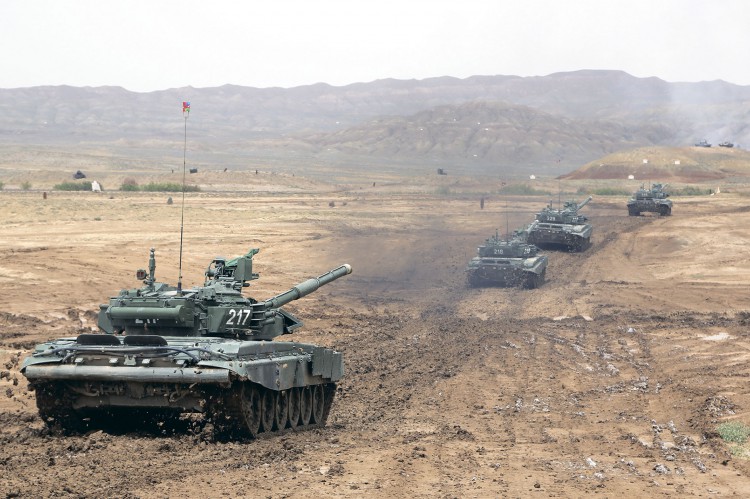Today marks the 23 year anniversary of the Bishkek protocol, a document that was signed in Kyrgyzstan’s capital on May 5, 1994 and called for an end to the war between Armenia and Azerbaijan over the Nagorniy-Karabakh region.
While the one-page document required “the non-resumption of military and hostile activities, withdrawal of troops from occupied territories,” and the return of refugees who fled the area as a result of hostilities, the conflict is nowhere near being settled.
Denis Denisov, Director of the Institute of Peace Initiatives and Conflict Studies in Moscow, says the legacy of the Bishkek protocol is that it marked an official end to the armed standoff between the two South Caucasus neighbors.
“The Bishkek protocol led to freezing the Nagorniy-Karabakh conflict,” Denisov told Caspian News. “However it was not able to fully settle the conflict.”
Azerbaijan, a constitutionally secular but predominantly Muslim country, roughly the size of Maine and situated in the Caspian and South Caucasus regions, has been at odds with its neighbor to the west, Armenia, even before the two post-Soviet states were created in December 1991. Following the collapse of the USSR, the two went to war over the landlocked region of Nagorniy-Karabakh, an area Armenian power-brokers had laid claim to as early as 1988 due to its ethnic Armenians population.
A military campaign by Armenia in the region began in late 1991; by October of the following year, Armenia’s armed forces had taken control of its first major town, Xojavand. As a result of the war, which lasted from 1991-1994, Armenia occupied Azerbaijan's Nagorniy-Karabakh along with several surrounding districts. Together, the occupied areas by Armenia account for 20 percent of Azerbaijan’s land mass.
Denisov believes that regional geopolitical progress is handicapped by the situation.
“This conflict is the powder keg within the Caucasus, without the resolution of which it is impossible to talk about both the strategic perspectives of the region’s development and its full-fledged inclusion in Eurasian integration projects,” Denisov said. “As long as this conflict exists, it will be a factor that can be used to destabilize the situation in the region and create new hotbeds of tension in the Caucasus.”
Azerbaijan’s Foreign Ministry Spokesperson Hikmat Hajiyev says the first step to be taken under the ceasefire regime was creating a fertile ground for the peaceful resolution of the conflict.
“The Bishkek Protocol was intended to be implemented immediately, including the withdrawal of Armenian troops from Azerbaijan’s occupied territories, and create long-lasting peace in the region,” Hajiyev told Caspian News.
The agreement was reached under the auspices of Kyrgyzstan, Russia and the Commonwealth of Independent States – a regional organization formed during the dissolution of the Soviet Union – and signed by representatives from Russia, Azerbaijan, Armenia and the Nagorno Karabakh Republic, an entity that is not recognized by the international community.
“Looking back, now 23 years later, we can see that unfortunately Armenia’s ongoing policy of occupation and annexation of Azerbaijan’s territories has prevented the ceasefire from being permanent,” Hajiyev said.
The Bishkek Protocol followed the passage of four resolutions by the UN Security Council in 1993, all which call for an immediate “cessation of hostilities and withdrawal of Armenian troops.”
Hajiyev says both the 1993 resolutions and the protocol urged parties to the conflict to create the necessary breathing spacing for ending the conflict peacefully, which Azerbaijan welcomed.
“The reason why the ceasefire agreement has not been permanent is that Armenia is making use of this agreement to keep the status quo in the region for over 20 years,” Hikmat Hajiyev said. “The status quo is illegal and unacceptable. The presence of Armenian troops in Azerbaijan’s occupied territories presents a potential threat to the region. The war in April once again proved that the conflict can put the entire region face to face with unexpected outcomes. ”
From April 1- 4 of last year, Armenia and Azerbaijan once more fought over the territory in what was the biggest armed confrontation since the 1990s. Known as the “April War” or “Four Day War,” the conflict was triggered when Azerbaijani forces came under fire. That skirmish, which ended in a ceasefire brokered by Russia, saw Azerbaijani forces reclaim two strategic hills, a village, and a total of about 5,000 acres of land.
Baku’s stance on the Nagorniy-Karabakh situation requires that Yerevan unconditionally fulfills all four UN Security Council Resolutions, ceasing its occupation of areas within Azerbaijan.
“The territorial integrity of Azerbaijan is not and will never be the topic of negotiations. Azerbaijan will not retreat from this position in any single step,” Azerbaijan’s President Ilham Aliyev has said, according to a statement posted to the president’s website.
Elkhan Shahinoglu, head of the Atlas Research Center in Baku, said Azerbaijan has expressed its readiness to give high-level autonomy status to Nagorniy-Karabakh as part of the settlement process, whereby the region can have its own government and parliament, with military and foreign policy issues controlled by Baku.
“But to make this happen, Armenia should liberate the occupied lands,” Shahinoglu told Caspian News. “This will pave the way for Azerbaijani displaced persons to return and participate in the governance of the region.”







 Armenian sappers commenced on Monday mine-clearance operations in the territories adjacent to the Saint Mary Church in village of Voskepar (Armenia...
Armenian sappers commenced on Monday mine-clearance operations in the territories adjacent to the Saint Mary Church in village of Voskepar (Armenia...
 President Aliyev emphasized the critical role of the North-South Transport Corridor in fostering transport cooperation between Azerbaijan and Russi...
President Aliyev emphasized the critical role of the North-South Transport Corridor in fostering transport cooperation between Azerbaijan and Russi...
 As the conflict between Ukraine and Russia escalates, the strategic importance of Kharkiv, Ukraine's second-largest city, has come sharply into focus.
As the conflict between Ukraine and Russia escalates, the strategic importance of Kharkiv, Ukraine's second-largest city, has come sharply into focus.



